THE OLYMPIA WEEKEND 2005
Orleans Hotel/Convention Center, Las Vegas
October 14-15
back
Ms. Olympia Report
By Bill Dobbins
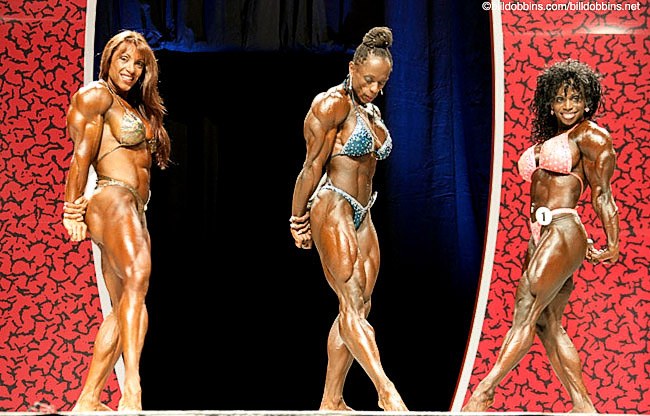 |
Yaxeni Oriquen, 1st. ----------------------------Iris
Kyle, 2nd.---------------------Dayana Cadeau, 3rd |
INTRODUCTION
Fans of female bodybuilding were shocked when it was announced that the Ms.
Olympia finals would not be held on Friday night along with those for the
Fitness and Figure Olympias but on the following Saturday in the Convention
Center – for free - as part of the Expo.
Originally the Ms. Olympia was supposed to be replaced by a model search. What
eventually took it’s place was a “Wild Card” round in which
male bodybuilders who were not qualified for the Mr. Olympia competed to
choose one individual who would receive an invitation to that contest the
following day. They ended up on stage for at least half the time in
what ticket buyers expected to be an evening of women’s competitions.
Bummer.
Yaxeni Oriquen - best she's every looked. |
The other disappointment Ms. Olympia fans were faced with was
the decision to do away with the weight divisions for female bodybuilding
and holding the contest using a single weight division. After years of complaints
that having pro female bodybuilders who were “too big” for any
kind of promotion to the mainstream audience (the myth being that this is
somehow possible), the IFBB and the NPC adopted the weight divisions in 2000
to encourage smaller and sleeker amateur competitors to enter pro shows and
to discourage smaller women from “bulking up” too much in order
to try and challenge the much larger women in the lineup.
Although the IFBB had to sign off on these decisions, both came essentially
from AMI/Weider, which bought a controlling interest in the Olympia last
year after buying Weider Publications some time earlier. The reports
we heard was that moving the Ms. Olympia from “prime time” to
the Expo was an attempt to improve pay-per-view sales and that doing away
with weight divisions was based on the perception that the men and women
should operate according to the same rules.
The last idea is a good one, but they chose the wrong course in achieving
that. The audience for the Mr. Olympia has been increasingly dissatisfied
that the event has evolved into a contest among huge muscular monsters – making
bodybuilding about being massive rather than aesthetically excellent – so
the IFBB men desperately need to reinstitution of weight divisions (which
existed for men through 1979). So weight divisions shouldn’t
have been removed from the women’s competition, they should have been
added to that of the men.
PREJUDGING
Prejudging for female bodybuilding, fitness and figure were held on Friday
morning at the Expo – a model created by Jim Lorimer for the Arnold
Weekend. This provides a large audience on which to draw, and there
is no fee to watch the women compete, but it is obvious that a stage in the
Expo hall does not have the facilities of a venue like the Orleans Arena
and there are certainly a lot more distractions which would encourage fans
not to sit and watch the whole event.
It also means that there is no ticket revenue for the women, which is bound
to affect the prize money. It also indicates that the organizers have
no faith in the drawing power of the women, a view that is mirrored by the
lack of promotion for fitness and figure, much less female bodybuilding,
in the Weider magazines during the year.
So when the 15 Ms. Olympia competitors came out on stage during prejudging
they were all in one class. The weights of the women varied considerably:
Yaxeni Oriquen 173
Betty Pariso 164
Betty Viana 160
Annie Rivieccio 160
Bonny Priest 158
Irik Kyle 157
Jitka Harazimova 145
Mah-Ann Mendoza 141
Brenda Raganot 140
Dayana Cadeau 138
Marja Lehtonen 135
Toni Norman 135
Desiree Ellis 133
Tonia Williams 132
Rosemary Jennings 128
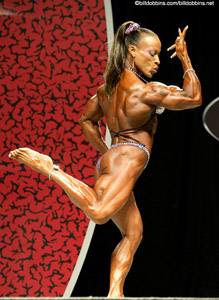 |
Rosemary Jennings, the smallest competitor in the line-up. |
The spread here is 45 lbs, an amount that is much greater relative
to female bodybuilders than it would be with men. (By the way, with no weight
divisions there was no weigh-in. We only have these statistics because
of the due diligence of Steve Wennerstrom, who functions as the Women’s
Historian for the IFBB).
It is also clear that the “mass-attractor” influence was a factor. With
no weight divisions, smaller competitors are motivated to come in heavier
than they should be, thinking this helps in competing against the bigger
bodybuilders. It almost never does, but a number of the women at the
Ms. Olympia would have weighed-in under 135 pounds who actually came in much
heavier. So much for the idea of creating smaller and more “presentable” female
bodybuilders to help promote the sport to the “mainstream” public.
Note: Apparently many of the female pros were asked to “vote” earlier
in the year whether to retain weight divisions or not. But it is apparent
after interviewing a number of them that many did not understand the nature
of this vote or the implications of the decision. And the idea
of “voting” on such a matter is problematical anyway. The
heavyweights are not likely to decide in favor of what they perceive as splitting
the money with lightweights and competitors in general are not necessarily
in a position to decide what is for the “good of the sport” or
not. This is a situation that calls for intelligent leadership on the
part of the federation.
In the beginning, the focus of the competition was on Iris Kyle for obvious
reasons. Iris won the Ms. Olympia title the past two years and was
the reigning champions. But the fact is you keep hearing from the IFBB
and AMI/Weider alike that they don’t believe she is not the kind of
champion that promotes the growth and popularity of female bodybuilding. Never
mind that the Weider magazines themselves seem to be doing nothing to promote
that growth themselves. But it is certainly a fact that Iris, like
4-time Ms. Olympia Kim Chizevsky, does not have the kind of “cover
model” looks that made somebody like Cory Everson so popular with the
magazines and the industry.
The prejudging call-outs focused on three women: Iris, the returning champion;
Yaxeni Oriquen, who finished 3rd in the heavyweight class last year behind
Lenda Murray; and Dayana Cadeau, Ms. Olympia lightweight champion in 2004
and this year’s lightweight Ms. International winner.
My first impression was that all of the Ms. Olympia competitors were in excellent
shape, that Iris might have been slightly off from last year, that Yaxeni
looked the best I’d ever seen her, and that Dayana Cadeau had the most
sensuous and sensual lines in female bodybuilding but perhaps could have
come in just a pound or two lighter.
Iris was hard and definined, in really excellent shape(I’ve only seen
her miss it once over the years) but I thought she looked a little too
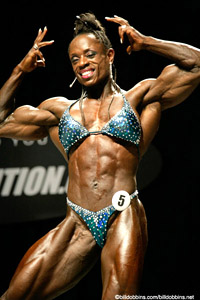 |
Iris Kyle - ripped but depleted. |
depleted
or dehydrated compared to how she looked in recent Ms. Olympias. Unfortunately,
when competition is close this kind of "drained" look can work against you.
This is just a thought, but sometimes bodybuilders continue to diet too
long and try to lose too much water before a show and this might have been
Iris’ situation. But
the difference was very small and as prejudging started it certainly seemed
possible she would win her third Olympia title in a row.
Yaxeni Oriquen has been in Ms. Olympia since the late 1990s and can be congratulated
for having gradually and regularly gotten better over time. This was
certainly the best she’d ever looked and she had the overall appearance
of energy and couple confidence that indicated she knew it. It was
obvious that this year she was going to present a serious challenge to Iris.
As defined, shapely and sensual as Dayana Cadeau looked she was just giving
away too much size. Dayana says she was 135 lbs, rather than the 138
as reported by Wennerstrom but no matter the exact figure she was still considerably
smaller than Iris (by about 20 lbs) and Yaxieni (by about 35 lbs). The
good big athlete having an advantage over the good smaller athlete, and all
that. I would still liked to have seen Dayana just slightly lighter. All
lightweights should realize that you can’t beat a heavyweight by gaining
body mass. What it takes is aesthetics and super conditioning, to be
at your best weight and not a pound more.
Jikta Harizimova of the Czech Republic came back to IFBB competition after
several years and qualified for the Olympia by winning the recent pro show
in Charlotte. She has a really beautiful physique, but as often happens
having to cycle being in top shape after winning one contest and then finding
out she’d be eligible for the Olympia was just too difficult for her
to look her best. But let’s hope she continues her pro career
because she is capable of being very good and is a great addition to the
sport.
Rosemary Jennings was also back and was in super shape, as ripped as she
has ever been and didn’t look like the smallest competitor on stage – which
she was. One new face worth mentioning was Toni Norman, with a sleek
and exotic look that is bound to take her far as a pro if she continues to
do the hard work that qualified her as a pro and brought her to the Olympia
stage.
One disappointment was Betty Viana. Betty is capable of being
as good as anyone but she needs to work harder on contest prep. Too often
her program for getting in shape is hit and miss. Unfortunately, this time
it was miss. This is just a reminder that once you are at this level in bodybuilding
dieting becomes the all-important factor.
As veteran contest watchers will tell you, the call outs by the judges tend
to give a good indication (but not always) of how they are viewing the contest. So
it seemed likely that Iris, Yaxeni and Dayana were being looked at as the
top three – but not that clear in what order the judges had scored
them.
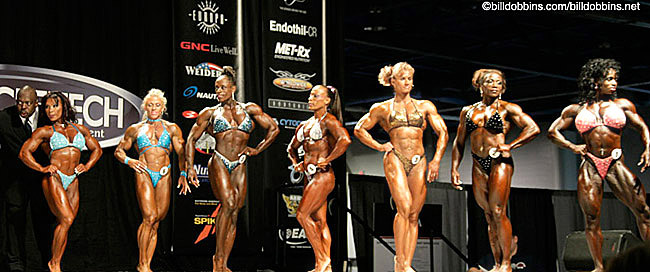
THE FINALS
After the problems and disorganization of the Friday finals for the figure
and fitness categories, it was almost a relief that the FBB finals were held
at the Expo on Saturday afternoon. The judges, press and audience in
the general seating didn’t have to sit 100 feet away from the stage
and the lighting, although not of theatrical quality, was bright enough for
everyone to see. When the organizers saw the crowds on hand to view
the women bodybuilders – filling all the seats and standing 10 deep
behind - the thought might have occurred to them that these people might
have provided needed bodies in the seats the night before. Perhaps
only a few hundred more ticket sales, but given the turnout at the Orleans
Arena the night before a significant improvement. Of course, a lot
of Ms. Olympia fans decided not to attend the Olympia weekend at all because
of the demotion of the Ms. Olympia, so it’s anybody’s guess how
many additional tickets might have been sold if this had not happened. Lenda
Murray reports that many of her Detroit fans, who come every year to see
her in a booth at the Expo, decided not to attend in 2005 because of how
the Ms. Olympia was being treated.
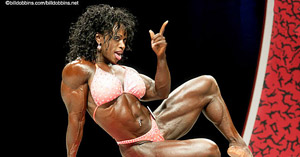 |
Dayana Cadeau - best posing
routine of her career. |
It would also have been nice to have all the women introduced
on stage before the posing round started, since many at the Expo would not
have seen prejudging the day before. As it was, the first competitor
out was Dayana Cadeau, whom I have thought in the past made too much of a
point in being “feminine” in
her presentation and not holding poses. But at the Ms. Olympia 2005,
Dayana performed a very artistic and certainly feminine routine, including
the clever use of a long, pink scarf – and she also flexed her muscles
and held the poses long enough for the judges and audiences to appreciate
her physique and for the photographers to get good photos. It was the
best posing routine she’s ever done.
Next out was Desiree Ellis, whose routine was also slow, artistic and designed
to let everyone see her muscles and state of conditioning. Photographer
Irv Gelb, who is not that much a fan of shooting the female bodybuilders
(unless he is paid for it) turned to me after Desiree’s posing and
exclaimed, “Those two routine were worth showing up for all by themselves!”
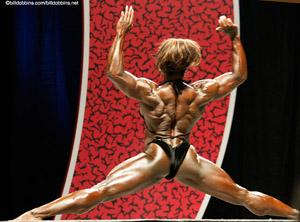 |
Desiree Ellis's routine "made
the event worth showing up for." |
Unfortunately the same can’t be said of many of the other posing routines. There were a few good ones and but there was too much dancing and prancing around, too little of holding poses, some meaningless waving of the arms and a lot of what seem to be presentation designed to say to the judges, “Hey, I’m not a big, strong female bodybuilder - I’m really just tiny and delicate and feminine!”
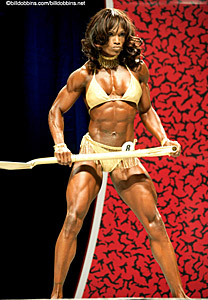 |
The sleek and exotic Toni Norman |
I’ve explained how posing needs to be done before, but
evidently it bears repeating:
1. Create interesting poses, hit them and hold them. Think
in terms of the photographers. If you hold a pose long enought for somebody
to get a picture of it, that means the judges and audience can see it as
well.
2. Don’t just show the judges compulsories.
They’ve already seen them. Make everyone pay attention by keeping
them guessing as to what you are going to do next.
3. Come up with attractive and interesting transitions
between poses and hold these long enough for the photographers to shoot them.
4. Don’t dance around. The posing round
is also a PHYSIQUE ROUND. It doesn’t exist to allow you to impress
the audience with the quality of your dancing, to show how sexy your are
or to prove to the world how feminine you are despite your muscles.
5. Don’t spend a lot of time prancing back
and forth from one side of the stage to the other. Move enough to give
the judges on either side a good look, but that’s all.
6. Stay in the light. The lighting usually
isn’t that good at the very back of the stage or the very front – nor
too far to either side.
7. Don’t spend a lot of time slowly walking
out on stage in the at the beginning of your routine. You only have
so much time, make use of it.
8. Use all your allotted time. Develop a routine
that keeps showing the judges/audience/photographers new aspects of your
physique. Don’t cut your posing short or just do the same poses
over and over. About the fourth time the judges see the same rear lat
pose (or whatever) they tune out.
9. Don’t pick popular music that everyone else
is going to use. At a contest years ago, half the women posed to “Chariots
of Fire.” This time we kept hearing “Don’t you wish
your girlfriend was hot like me…” over and over.
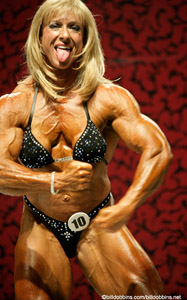 |
The ever-entertaining Betty
Pariso |
A lot of the posing was acceptable, but except for Dayana and
Desiree none of it was memorable. Iris Kyle has always been known as
a less than adequate poser. In this year’s contest she was not
particularly good but at least adequate. She still hit mostly compulsory
poses, her routine lacked creativity and it was too short, but she did stay
in front of the judges most of the time instead of disappearing off to the
sides of the stage. Iris needs to work on developing a more interesting
and creative routine, something that focuses on the aesthetic quality of
her physique.
I didn’t keep notes on everyone’s posing routine (I was shooting
photos at the time) but I think it’s generally true that the female
pro bodybuilders need to work on making the free posing round the
high point of the contest and the round in which each is able to draw attention
to her best physical qualities and away from any weak points – which
is what this round is supposed to be about in the first place. Certainly,
Yaxeni did a competent routine that showed off her best qualities. Toni Norman
used a shovel as a very effective prop. Bonny Priest's approach to posing
is traditional but she certainly knows how to hit and hold her poses. Betty
Pariso, as usual, not only showed off her physique well but added some humour
to the event with parodies of male poses.
THE POSEDOWN
Along with learning how to take advantage of the posing round, many female
bodybuilders have a lot to learn about posedowns. Now, it’s true
that in most posedowns the judges have already made their decisionsand what
the competitors do on stage is largely for show. However, (1) can you
afford to assume you can have no influence on the judges at this point? and (2)
why not put on the best show possible?
The judges and audience have already seen the competitors side by side being
compared in prejudging. They have already seen each of the bodybuilders
do their own posing. What they haven’t seen are the competitors
side by side doing the poses of their choice to try and outdo their rivals. The
posedown is the one opportunity the competitors have to attach their closest
rivals and perhaps lift themselves up a place – and certainly to bring
themselves up in the estimation of the press and the audience. (This
is a free form “challenge round” that is much more in the tradition
of bodybuilding than the awkward Challenge Round being used in the Mr. Olympia.)
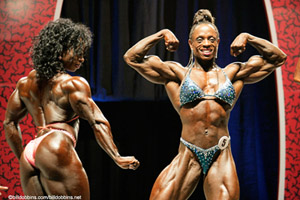 |
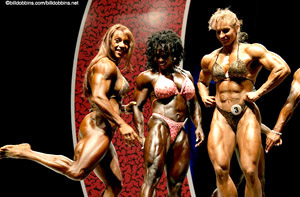 |
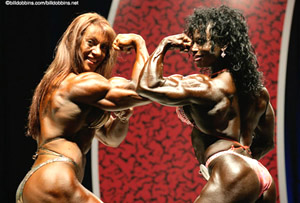 |
Bodybuilders should zero in on the competitors they think are
their nearest rivals and try to blow them off the stage by hitting poses
in which they feel they are superior. In posedowns against Sergio Oliva
in the late 1960s and early 1970s, Arnold Scwarzenegger would pick his poses
carefully to avoid direct comparisons with Sergio’s most impressive
body parts. All
bodybuilders in posedowns should think along the same lines. Don’t
wander off to the side of the group and pose to the audience; don’t put
on personal posing exhibitions for your fans. Even if you are far and
away the winner, not getting into the middle of the group and challenging
your opponents takes away from the excitement – and women’s pro
bodybuilding needs all the excitement it can get.
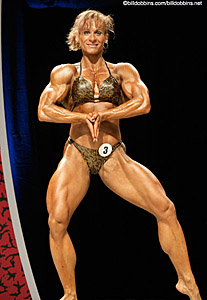 |
Jitka Harizimova - just one contest too many. |
Actually, the posedown at the Ms. Olympia 2005 was better than
many have been in the recent past. Yaxeni, Iris and Dayana – the obvious
top three – spend a lot of time in a tight group hitting a lot of poses
in succession – and it was exciting. The posedown confirmed that
Yaxeni was the biggest and seemed less depleted than Iris and that Dayana
has an incredibly sensuous physique but is much smaller than the other two.
And that’s the order they finished: Yaxeni first, Iris second, Dayana
third and Jitka Harazimova 4th – which is not bad for somebody who
came over from Europe a few weeks earlier to compete at Charlotte and had
no idea she would qualify to compete in Vegas.
To Marja Lehtonen, 14th, I would advise working on her color. By the
time you get to the Ms. Olympia that should be an aspect of competition you
have totally mastered. And to Desiree Ellis, 15th, I know she will
be disappointed in that placing but she should take solace in the fact that
her posing routine was one of the high points of the event.
CONCLUSION
It is interesting that, amid the chaos, confusion and incompetence of the
Olympia weekend that one island of order and stability was the Ms. Olympia
finals – the contest that was demoted from center stage at the Orleans
Arena to sideshow at the Expo. The event was conducted simply as a
regular IFBB contest, run by the usual IFBB expediters and judged by regular
IFBB officials. No muss, no fuss, no bother. No organizer micro-management.
Prior to the contest there had been a lot of speculation about how the judging
would be conducted, centering on the idea that the IFBB would rather Iris
Kyle not win another Ms. Olympia title. But Yaxeni looked the best she ever
has so nobody can really claim the decision was (primarily) political. The
audience certainly wasn’t outraged by the decision.
I did feel bad for Dayana Cadeau, however. She was the reigning Ms.
Olympia lightweight and, for my money, she still is. The fact that
the IFBB unwisely decided to do away with weight divisions shouldn’t
diminish her accomplishment. She not only beat all the lightweights
but all but two of the heavyweights as well. Good for you, Dayana.
Picking Yaxeni as the winner also says something about the judges. We
have heard a lot of talk about how the female pros are getting “too
big” and they gave the title to the biggest competitor in the lineup
by far! As I’ve always contended, if you leave IFBB or NPC judges
alone to exercise their best judgment, take away the political pressure they
are too often subjected to, eliminate factors like who is signed to what
sponsor or has which manager, and you end up with consistenly reasonable
and accurate results.
Iris Kyle didn’t win this one and it isn’t because she doesn’t
have an outstanding physique. Iris needs to learn something from the
career of Kim Chizevsky. Kim was winning shows in the mid 1990s but
was criticized because of her “overall appearance” – her
face was deeply lined due to diet and dehydration and her hair and make-up
weren’t up to the quality needed. But when she competed at the
1999 Ms. Olympia in New Jersey she had fixed all that. No lines in
the fact, beautiful make-up and grooming, plus a sleeker and diamond sharp
physique. She ended up making all the improvements the IFBB had been
telling her she needed to make.
Unfortunately, it was too late. Nobody in the IFBB noticed (in spite
of the fact that Jim Manion was at the show and commented on how attractive
she had become). She was pressured to get out of bodybuilding and into
fitness, where she was rewarded with higher placings than she deserved. It
would be great if there were no political interference in the sport, but
since there is political interference in everything that is never going to
happen. Interestingly, when she was in fitness people kept commenting
on how pretty Kim looked and attributed the change to switching away from
bodybuilding. But that face they admired was the same one we saw on
stage in 1999 when Kim was still a bodybuilder! But we all know that
giving some people the facts only confuses them.
Still, what Iris needs to start working harder on what they call “overall
appearance.” Jitka Harazimova needs to come in as hard at the
Olympia as she did at the contest in which she qualified. Brenda Raganot,
5th place, and a lot of the other “lightweights” need to enter
at their best weights and not let the elimination of the lightweight class
cause them to compete at too heavy a bodyweight – but to realize that
competing against the heavyweights is nonetheless an uphill battle. Toni
Norman needs to just keep doing what she’s doing and she’ll move
up into contention in no time at all.
And the IFBB needs to reinstate weight divisions for women, the Olympia organizers
should stop treating the women in general and female bodybuilders in particular
as second class competitors (this is the only sport in the world that has
institutionalized gender discrimination), the magazines in general and Flex
in particular (which didn’t even put results of the women’s contests
on its website) need to realize they are losing both sales and credibility
by failing to cover female muscle.
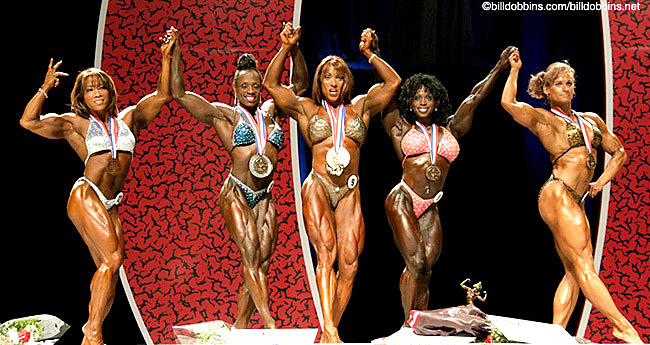
I can’t tell you what to do about the war in Iraq or
how to protect the world against avian flu – but I’ve been doing
this a long time and I KNOW that the industry is shooting itself in the foot
by not exploiting the worldwide interest in aesthetic female muscle. Forget
the physique magazines for a moment – go to Google and type in “female
muscle” or “women
bodybuilders.” What you get is thousands of results. Far
more than for the men. The audience is out there. But if you want to
sell them contest tickets, issues of physique magazines or a variety of products – YOU
NEED TO APPEAL TO WHAT THEY LIKE. Not just assume there is “no
market for the women.”
Thus endeth the sermon.
Complete photo coverage in subscriber area